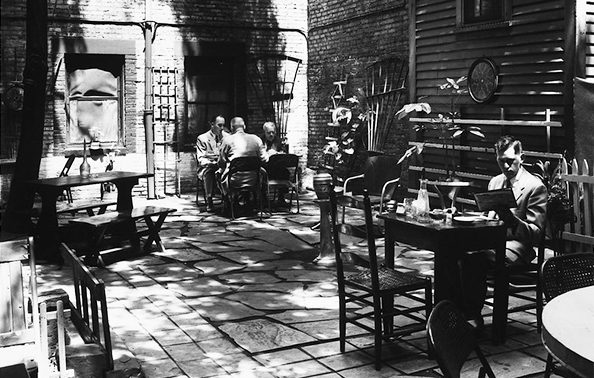In 1934 Lucie Keyser Frolich and her husband, Bernhard, decided to open into a restaurant near Boston’s Park Square, even though neither had any experience in the business. Here’s how Lucie Frolich would later tell the story:
“The great depression of 1929-1933 practically forced my late husband and me into the restaurant business. This is how it happened. A very discouraged Norwegian architect was sauntering along the streets of Boston one day. He stopped for a moment on Carver Street, struck by the rustic atmosphere of number fourteen. Ola was conceived right then and there, and in less than ten days the new restaurant was born.”
In the early days the restaurant, visible through an iron-gated entrance at 14 Carver Street, was Ola Kaffehus, signaling the Norwegian heritage of its owners (as well as their partners, Olaf and Sallie Amundsen). From almost the start Lucie was known as “Madame Ola” or “Mrs. Ola” and Bernhard—“a six-foot-two Viking,” as Lucie described him—as “Mr. Ola.” But when Bernhard died just three years after the restaurant opened, Lucie was thrust into the role of sole proprietor, a role in which she would remain for nearly 30 more years.
As Ola Restaurant thrived, Lucie Frolich acquired quite a large following in Boston, and in 1946 she published Ola’s Norwegian Cook Book, which she sold in the restaurant and at the Norwegian Arts & Craft Shop on Beacon Street. “I dedicate this book to you good Bostonians who have favored and been faithful to my little Ola for more than ten years,” she wrote in the introduction to the book. “Depression, war, rationing—you came regardless, with pleasant smiles on your faces.”
One of those Bostonians was Alice Saltonstall, the wife of Leverett Saltonstall, a lawyer who served two terms as the governor of Massachusetts (from 1939 to 1945) and more than 20 years as a U.S. Senator (1945 to 1967). Her sewing circle dined on Mrs. Ola’s meatballs, which Mrs. Saltonstall proclaimed the “best in Boston,” every Wednesday for an entire year.
In 1960 the restaurant acquired a little mascot of sorts when Frolich got a little puppy—part beagle, part cocker spaniel—she named Bimbo. When Bimbo went missing one day, she offered an award for his return through an ad in the Boston Globe’s lost-and-found classifieds, but it’s not clear if they were ever reunited.
After Frolich died at age 65 in 1964, two longtime customers took over as the owners, but Ola’s Restaurant closed in 1966 and a new restaurant, Dante’s, opened in the same space. The building at 14 Carver Street and the houses on both sides of it were demolished in 1979 as a massive redevelopment project rearranged the street pattern in Park Square and the South Cove. What remained of Carver Street was renamed Charles Street South.
Here’s the recipe for one of Restaurant Ola’s most popular dishes: Meatballs with Onion Sauce. The secret? “I always put sugar in my potato salad, in my meatballs, too,” Lucie Frolich once explained to a reporter. “Sugar brings out the full flavor of meats and vegetables. Housewives of Norway keep their seasoning simple—salt, pepper, a little onion and sugar, always sugar.”

Small Meatballs with Onion Sauce
Ingredients
- For meatballs
- 2 pounds ground bottom round steak
- 1/2 pound ground pork
- 2 cups fine breadcrumbs
- 3 eggs
- 2 cups beef stock
- 1 tablespoon sugar
- 1 teaspoon ground mace
- For sauce
- 2 tablespoons butter
- 5 onions, very thinly sliced
- 1/2 cup strong black coffee
- Salt and pepper to taste
- Liquid reserved from cooking meatballs
Instructions
In a large bowl, combine all the ingredients and mix thoroughly by hand (the more kneading the better).
Roll the meat mixture into 1-inch balls (about two tablespoons each).
Warm two tablespoons butter or shortening in a large skillet (preferably cast iron) set over medium to medium-high heat. Working in batches, cook the meatballs until they are well browned on all sides, shaking the skillet to turn the meatballs rather than using a knife or fork (see preparation note below). After each batch, rinse the skillet with a small amount of water or beef stock, saving the liquid for the sauce.
Keep the meatballs warm while preparing the sauce.
In a large sauté pan, cook the onions in until they are nicely browned, stirring constantly and adjusting heat as needed.
Add coffee, stirring constantly, and simmer for few minutes. Season with salt and pepper as needed and add the liquid reserved from cooking the meatballs.
Simmer an additional 5 minutes. Pour the sauce over the meatballs just before serving.
Notes
Here's some advice on preparing the meatballs from Lucie Frolich: “Brown them quickly in a hot pan, then reduce the heat to very low. This way the meat balls are juicy inside and the brown flavor adds richness to the gravy." Froliuch also said that she shortened the cooking time consideraly when the meat balls were to be reheated in the sauce.










No Comments